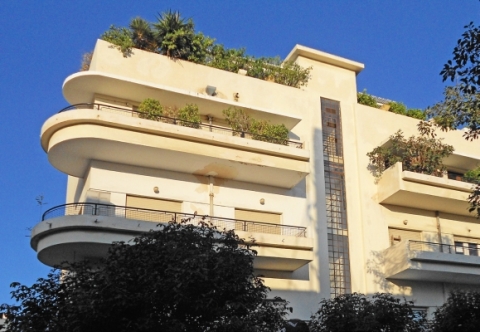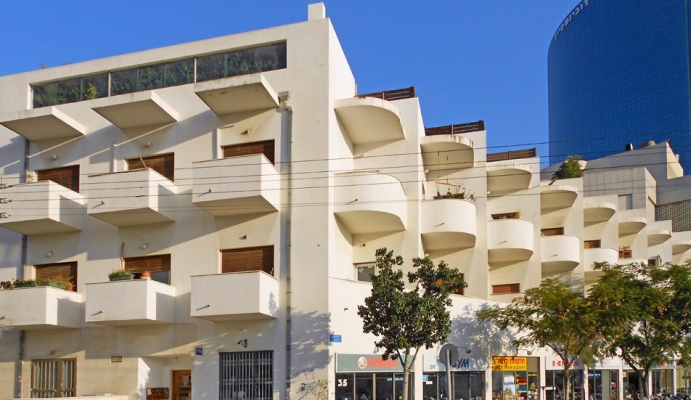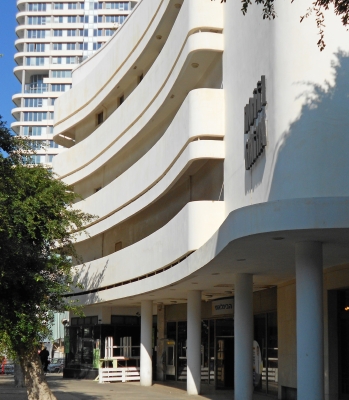The White City of Tel Aviv
20 Years as a World Heritage Site
The Land of Israel is considered the Jewish people's ancient homeland. Founded in 1909, Tel Aviv symbolized the future of the Jewish people.
In 2003, UNESCO proclaimed the White City of Tel Aviv as a World Heritage Site. The proclamation referred to the many hundreds of buildings constructed in the 1930's and 40's in the International or Bauhaus Style, in an area of Tel Aviv called the White City.
The urban plan of the White City had been proposed by Sir Patrick Geddes (1854-1932). Based on the idea of the garden city, every single building is surrounded by a green garden and the city is characterized by a hierarchical system of streets.
All buildings within the White City were constructed according to the rules of modernism - no decoration without function. The minimalistic architecture included dwellings, schools, theatres, cinemas, synagogues, infrastructure buildings, and industrial complexes as well. Isolated modernist buildings or even modernist neighbourhoods can be found in different places all over the globe, but Tel Aviv is unique, as it presents a whole city in all its aspects, all in International Style.
In the 1930's and the 1940's, the 5th Aliya (immigration wave) with more than 200,000 new Jewish immigrants escaping Europe, reached Mandatory Palestine. The task of local architects was to construct housing for the rapidly growing population. The International Style, using reinforced concrete based on mostly local materials was a good choice. The cubic buildings were not only quickly constructed and suitable for the local climate; they also reflected the socialist ideals of many of the new immigrants. The modernist architecture is egalitarian in the way it provides different tenants with the same services, every floor looks the same, facades are uniform and lack decoration.
With some 4000 buildings in modernist style and around half of them under preservation law, Tel Aviv has the largest number of International Style buildings worldwide. The architects involved in this huge project never intended to build a World Heritage Site. Their goal was to provide functional, modern and affordable homes suitable for all. Of the approximately 150 architects involved in the construction of the White City, four studied at the Bauhaus School for Architecture in Germany: Shlomo Bernstein (1907-1969), Shmuel Mestechkin (1908-2004), Chanan Frenkel (1905-1957) and Arieh Sharon (1900-1984). A considerable number of women architects were also involved in the project, revolutionary for the first part of the 20th century. Among them were Genia Averbouch (1909-1977), Lotte Cohen (1893-1983), Elsa Gidoni-Mandelstamm (1901-1978), and Judith Stolzer-Segall (1904-1990).
The buildings of the White City suffered neglect during the second half of the last century. Many people left for new areas in North and East Tel-Aviv. Only the fine construction of these buildings saved them from falling apart. With the UNESCO Proclamation 20 years ago, the municipality designed a plan for their renovation and revival. The main idea of this plan was to encourage the owners of private houses to renovate their buildings by granting them construction rights. Owners of listed buildings, are now in most cases allowed to add up to three floors if they agreed to renovate the whole building.
In terms of urban revival and architectural preservation, the White City can be seen as a huge success. The heart of the local Bauhaus City has changed rapidly. More and more of its modernist gems look as attractive today as when they were first constructed in the 1930's and 1940's. People have returned to live in the district. Urban life is flourishing - with new shops, cafes, bars, restaurants and hotels springing up. The overall success of the plan has been so large, that the White City now suffers from an impactful gentrification effect. Today, only wealthy people can afford the high prices in this area. In 2021, Tel Aviv, the capital of modernism, was declared the most expensive city worldwide. It is now the municipality's task to find a balance between rising prices and the professional preservation of Tel Aviv's World Heritage Site.
About the Bauhaus Center Tel Aviv:
The Bauhaus Center, established in 2000, presents the World Heritage Site of the White City to the public in various ways: It organizes guided and self-guided architectural tours, hosts changing exhibitions, runs a publication house and the Bauhaus Center Shop.
This email address is being protected from spambots. You need JavaScript enabled to view it.
facebook.com/bauhaus.center
Instagram: bauhauscenter










Comments